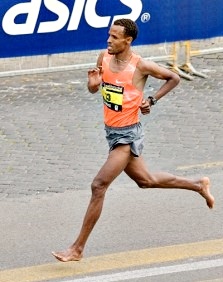Most elite marathon runners wear cushioned running shoes, but they still get injured, maybe not as much as recreational runners, but many elites do get injured, causing them to pull-out of major events. Because they are so well-conditioned, injuries at the elite level should be rare.
Elite runners, by in large, should not be getting injured, yet they do. You would think that the multi-billion dollar running shoe business would do a better job at preventing injury in recreational runners, and especially in elite runners. For instance, a few years ago, Kenenisa Bekele pulled out of the London Marathon because of an Achilles injury, an injury more prevalent in recreational runners. In the past, Tirunesh Dibaba missed at least 2 years battling shin splints, another injury common in recreational runners. So, why are these high-level runners vulnerable to the same injuries as ‘inexperienced’ joggers? The core answer could be shoe cushioning.
Could Cushioned Footwear Be the Reason Elite Runners Get Injured?
Because of their high conditioning level and exceptional biomechanics, you would think that elite runners are unbreakable, yet scientists and laypeople alike have historically attributed running injuries to poor biomechanics, poor muscle strength and inflexibility. One study shows that cushioned footwear are the main component of the problem.
In their study, Robbins et al. 1988 suggested the following:
“There is good reason to suspect that cushioned footwear that have pronation correction, rearfoot control, arch support and excessive cushioning are inadequate because there have been no data that directly supports their validity and various reports that are inconsistent with their predictions”.
“Highly protective footwear do not provide enhanced protection as evidence by the high incidence of running-related injuries associated with their use (1, 2).”
Based on their reasoning, could elite runners fare better and avoid injury if they wore minimalistic shoes, like the Vibram FiveFingers or the Vivobarefoot? No one knows this answer because it’s never been done before. However, many Ethiopian runners have ran marathons barefoot and won, which ironically coincides with the following excerpt:
“The paradoxically low incidence of similar injuries reported in barefoot populations implies that modern footwear may produce injuries that normally would not be present without their use (3).”
Therefore, cushioned running shoes serve as a threat to any runner’s, elite or novice, performance because runners get injured wearing them, mainly because footwear completely interferes with our foot’s proprioceptive system –the body’s natural feedback control system where the nerves in the sole of the bare foot communicates to the brain to influence load magnitude and temporal loading during running. This feedback control system is the main safety-net that enables barefoot runners to run any distance without injury. Barefoot running should be universally recognized as the safest way to run since more and more researchers found evidence that running barefoot directly influences safer running mechanics as compared with running shoes.
Most of our landing behavior is based on how we process information from the ground and therefore how we perceive the ground. How we strike the ground with our feet depends heavily on very basic processes in the brain –our ancient instincts to avoid danger by inducing avoidance behavior based on the stimulation of noxious plantar skin sensations (4). Based on this fact alone, hopefully more coaches would be more willing to entertain the idea of less is more, including barefoot training.
Sure, all the of the world records were broken wearing athletic footwear, but much of the athlete’s journey involved some form of injury. Just imagine how much farther these runners, including ourselves, can run if we never incurred any injury?
More on the Benefits of Training Barefoot:
Best Barefoot Running Websites
References:
- Caspersen et al. The incidence of injuries and hazards in recreational and fitness runners. Med Sci Sports Exer, 1984, 16, 113.
- Powell et al. An epidemiological perspective on the causes of running injuries. Phys Sportsmed, 1986, 14, 100-14.
- Robbins et al. Running related injury prevention through barefoot adaptations. Med Sci Sports Exerc, 1987, 19, 148-56.
- Maimonides, M. The Guide of the Perplexed, Vol 2 (S. Pines translator). Chicago, IL. The University of Chicago Press, 1963, p. 465.
Bretta Riches
BSc Neurobiology; MSc Biomechanics candidate, ultra minimalist runner & founder of RunForefoot. I was a heel striker, always injured. I was inspired by the great Tirunesh Dibaba to try forefoot running. Now, I'm injury free. This is why I launched Run Forefoot, to advocate the health & performance benefits of forefoot running and to raise awareness on the dangers of heel striking, because the world needs to know.
Latest posts by Bretta Riches (see all)
- Can You Run In Barefoot Shoes? Yes, But DON’T Heel Strike! - 21/07/2024
- Why Cushioned Running Shoes Are Really Bad for Your Feet - 19/07/2024
- Do Cushioned Running Shoes Cause Injuries? - 17/07/2024

